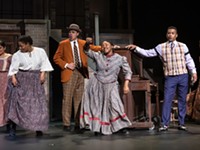[
{
"name": "500x250 Ad",
"insertPoint": "5",
"component": "15667920",
"parentWrapperClass": "",
"requiredCountToDisplay": "1"
}
]
Twentieth-century photographer Lewis Hine focused largely on labor, with two equally important aims: envisioning and advocating for social change, and celebrating the progress humankind makes when individuals work well together. Recently returned from a three-year, international tour, and currently on view at George Eastman House, is an exhibit of Hine's photographic prints and materials drawn from the Eastman House's own extensive collection. The show reveals Hine's important legacy as a careful and compassionate observer, and provides a poignant reminder that abuse of power revels in the absence of observation and advocacy.
It would be easy to view this show with a sense of satisfied finality about horrific labor conditions and human rights violations, but as described by Renan Salgado, Human Trafficking Specialist with the Worker Justice Center of New York, our work is far from finished. Salgado toured the exhibition with CITY, commenting on parallels between Hine's work and some of today's labor issues taking place right in our backyard. For Salgado's thoughts, click here.
The exhibition is split into sections marked by gray stripes and informational texts, each including images Hine created for specific organizations or toward specific projects, and the show moves in a fairly chronological order with some overlap. Also on view are posters and progressive journals of Hine's day, with stories and studies about child labor, workplace conditions and safety, and injuries, all anchored and driven home by Hine's images.
Hine didn't originally set out to make photographs as a tool to illustrate the socioeconomic issues of the day. He grew up in Wisconsin and studied to be a teacher, eventually working with a man named Frank Manny, who brought Hine along when he moved to New York City to lead the progressive Ethical Culture School. There, Hine taught Earth Science and began taking images of school activities under Manny's suggestion. Having become involved in progressive movements, some of which encouraged people to accept immigrants without prejudice, Hine ventured out to Ellis Island to begin his first photographic project — documenting the faces of the masses huddling under Lady Liberty.
This first section of the Eastman House's exhibit includes prints made between 1903 and 1909, and in 1926 on a return trip. During this early stage, Hine developed his straightforward, simple focus on individuals, using the medium's expressive potential to elicit sympathy from the viewer and affect the reform he hoped would take place as a result of his photographs. The photographer's own words are included in many captions, describing the story behind the photographs. In one image, an anxious and weary group lingers in a room full of lost luggage. In "Italian Madonna," mother and child become an allusion to a holy family in flight.
In 1908, the National Child Labor Committee hired Hine to document the lives of immigrants after they left Ellis Island. Images in the "Tenements" section of the show give us glimpses into NYC and Chicago, where dirty children linger on the streets and in shabby homes, waiting to help garment worker mothers who bring piece work home to be completed off-hours by the whole family.
Subsequently, Hine traveled the states documenting child labor, from the masses of exploited young newsies in New York City, to children working in coal mines and in mills. "In order to get into a lot of the mills and factories, Hine had to pretend that he was an insurance salesman, or fire inspector," says Jessica Johnston, who is Associate Director of the PPCM Master of Arts Program at George Eastman House. Entering under false pretenses, Hine would document the conditions, and interview and photograph the kids. This was an impressive covert endeavor, considering the size of his cameras and the audacity of the magnesium flash.
But Hine didn't only document the abused and the underprivileged. A wall-mounted quote by the photographer sums up the show well: "There are two things I wanted to do. I wanted to show the things that had to be corrected. I wanted to show the things that had to be appreciated."
Hine's optimism is evident in his documentation of the Red Cross' relief work with refugees in a post-WWI Europe, and in the buoyant expressions of resilient and playful children. He crucially documented of the struggles of violently impoverished African-Americans in the 1920's, but his portraits of black university students breathe a sincere sense of hope and respect.
Hine's work contributed, among other things, to the passage of federal child labor laws. As the show moves forward in time and as progress was made toward various humanitarian ideals, Hine's focus shifted to the dignity of work, and the celebration of industry. All manner of workers, from cigar-makers, to cooks, bookbinders, clerks, and construction workers, were recorded with the same reverence.
With one eye drinking in the wonders of the machine age, Hine maintained a defiant emphasis on humanity as the center and at the helm, exhausted but proud. This is perhaps best illustrated by his famous image, "Powerhouse Mechanic," in which a worker is incredibly framed by machinery, his muscled form itself a powerhouse.
Hine's harrowing documentation of the construction of the Empire State Building served to immortalize the worker component of an immortal structure, emphasizing the unacknowledged masses, and the team effort behind the shaping of this modern world. With not one safety harness in sight, Hine was up there with them, documenting and encouraging such antics as a steelworker playfully "touching" the tip of the eclipsed Chrysler Building.
Speaking of...
-

Culture Vulture
Jun 15, 2023 -

“Ragtime” evokes history through rhythm and rhyme
May 8, 2023 -

Six art shows you shouldn’t miss this fall
Sep 1, 2021 - More »
Latest in Art
More by Rebecca Rafferty
-

Beyond folklore
Apr 4, 2024 -

Partnership perks: Public Provisions @ Flour City Bread
Feb 24, 2024 -

Raison d’Art
Feb 19, 2024 - More »




